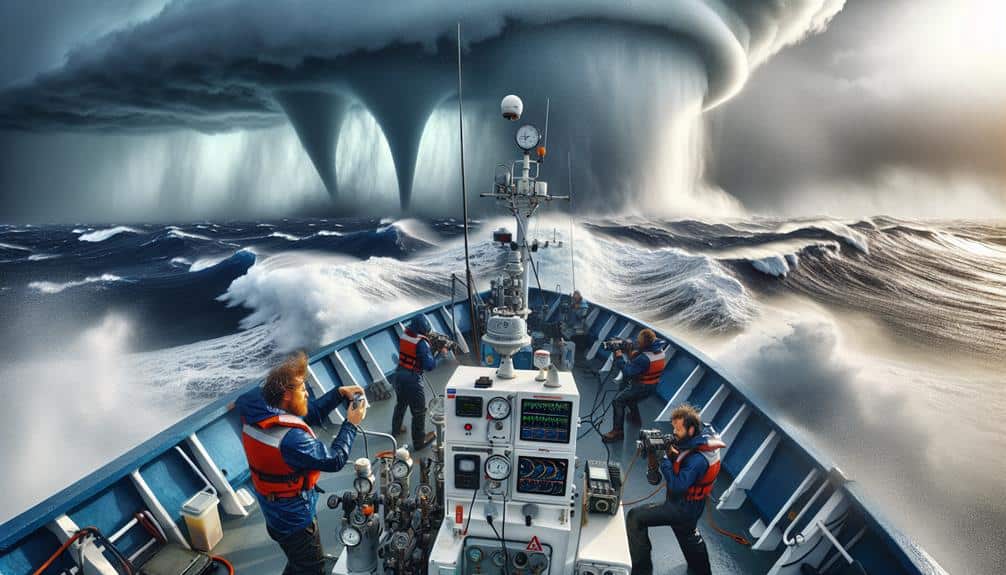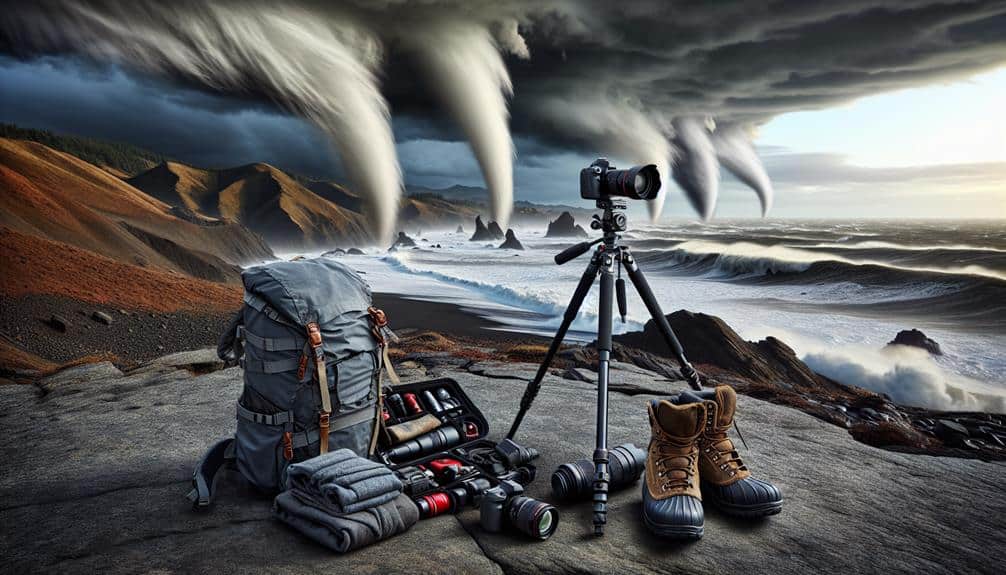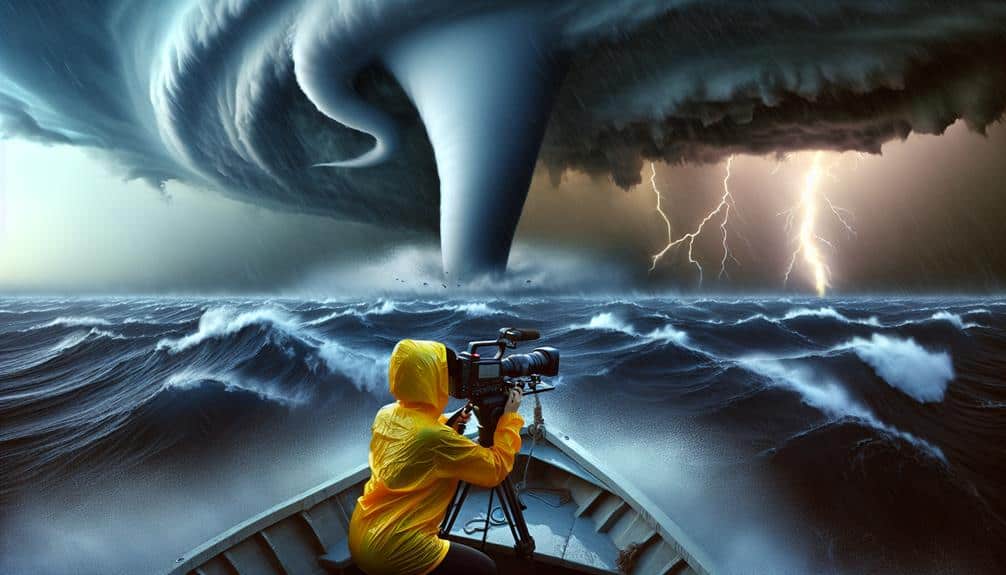Chasing waterspouts allows us to understand their formation under specific atmospheric conditions, such as high humidity and unstable air. By analyzing their structure and behavior, we improve forecasting accuracy and safety protocols. We utilize advanced tools like Doppler radar and aerial photography to collect real-time data and monitor their movements. This research also sheds light on waterspouts' ecological impact, helping us protect marine habitats. By integrating data from various sources, we deepen our knowledge of weather patterns and environmental changes. There's much more to discover about these fascinating phenomena.
Key Points
- Understanding waterspout formation enhances weather prediction accuracy and safety measures.
- Analyzing waterspout behavior improves knowledge of severe weather systems.
- Real-time tracking aids in developing early warning systems for marine and coastal areas.
- Studying waterspouts' impact on marine life informs conservation strategies.
Formation and Characteristics
When we explore the formation and characteristics of waterspouts, understanding the specific atmospheric conditions that facilitate their development is essential. Waterspouts, a fascinating meteorological phenomenon, typically form over warm bodies of water under conditions of high humidity and unstable air. We observe that these conditions are often present in tropical and subtropical regions, where the warm water heats the overlying air, creating an environment ripe for waterspout formation.
We note that there are two main types of waterspouts: fair-weather waterspouts and tornadic waterspouts. Fair-weather waterspouts develop in non-severe weather conditions and are usually less intense. They form along the dark, flat bases of cumulus clouds where the atmospheric conditions include light wind shear and a significant temperature gradient between the water and the air above it.
In contrast, tornadic waterspouts are associated with severe thunderstorms and share similar characteristics with land-based tornadoes, including strong updrafts and intense wind shear.
Safety Precautions
As we chase waterspouts, we must prioritize our safety by maintaining a safe observation distance.
We'll review emergency preparedness tips to handle unexpected situations effectively.
Additionally, we'll discuss the essentials of protective gear to guarantee our well-being during these pursuits.
Safe Observation Distance
Establishing a safe observation distance from waterspouts is essential to minimizing risk and ensuring the safety of all involved. We must understand the potential dangers associated with these natural phenomena. Waterspouts, while visually striking, can rapidly intensify and change direction, posing significant threats to anyone too close. Our priority should be maintaining a distance that allows us to observe and study these phenomena without putting ourselves at unnecessary risk.
When it comes to observing tips, we should always adhere to established distance regulations. Experts recommend staying at least several miles away from the core of the waterspout. This distance not only reduces the risk of encountering high winds and flying debris but also allows us to capture more thorough data and imagery. By following these guidelines, we create educational opportunities for ourselves and others, facilitating a better understanding of waterspouts in a safe manner.
Moreover, using tools like binoculars, high-zoom cameras, and drones can enhance our observations while keeping us at a safe distance. Let's embrace these methods to satisfy our curiosity and thirst for knowledge without compromising our safety. By doing so, we can enjoy the freedom of exploration and learning while staying secure.
Emergency Preparedness Tips
While maintaining a safe distance is important, we must also prepare for emergencies by implementing thorough safety precautions. To start, establishing clear evacuation routes is necessary. Knowing multiple paths to safety helps make sure we aren't trapped by shifting weather patterns. We should carefully map out these routes in advance, taking into account the local geography and potential obstacles.
Communication plans are another crucial component. We need to establish reliable methods of staying in contact with our team members, especially given the unpredictable nature of waterspouts. This might involve utilizing satellite phones, radios, or other devices that can function independently of local infrastructure.
In addition to planning our escape and communication methods, we must also assemble detailed emergency supplies. These should include first aid kits, non-perishable food, potable water, and essential medications. Preparing a well-stocked emergency kit can make the difference between a manageable situation and a crisis.
Lastly, identifying suitable shelter options is essential. Whether it's a sturdy building or a designated safe zone, knowing where we can take refuge in case of a sudden threat is key to our safety. Preparing these elements allows us to pursue our passion for chasing waterspouts without compromising our safety.
Protective Gear Essentials
Our safety hinges on equipping ourselves with the right protective gear designed to withstand extreme weather conditions. When chasing waterspouts, we must make sure our gear includes high-quality waterproof clothing, sturdy boots, and protective eyewear. Waterproof clothing keeps us dry and reduces the risk of hypothermia, while sturdy boots provide traction on slippery surfaces. Protective eyewear shields our eyes from debris and strong winds.
Regular equipment maintenance is non-negotiable. We need to inspect our gear for wear and tear before each outing. A minor flaw in our waterproof jacket or a crack in our goggles can jeopardize our safety in harsh conditions. By maintaining our equipment rigorously, we extend its lifespan and reliability, guaranteeing we're always ready for unexpected weather challenges.
Weather monitoring tools are equally essential. Portable weather radios and smartphone apps provide real-time updates on approaching storms and waterspouts. We must calibrate these devices regularly to secure their accuracy. Advanced weather monitoring allows us to make informed decisions, avoiding unnecessary risks.
In essence, our protective gear and diligent equipment maintenance, paired with precise weather monitoring, form the foundation of our safety strategy while chasing waterspouts. These precautions grant us the freedom to explore nature's phenomena without jeopardizing our well-being.
Data Collection Methods

In our pursuit of understanding waterspouts, we utilize advanced instrumentation and tools to gather accurate data.
We also employ detailed observational techniques to conduct thorough analysis.
These methods enable us to capture critical information about the formation, behavior, and impact of waterspouts.
Instrumentation and Tools
Accurate data collection during waterspout chases relies on an array of advanced instrumentation and tools. We employ a variety of measuring devices to capture critical meteorological parameters such as wind speed, temperature, and barometric pressure. These devices are calibrated to guarantee precision, enabling us to gather high-quality data. Accurate data analysis hinges on this initial step, as even minor inaccuracies can skew our results and lead to false conclusions.
In our research applications, tracking software plays an essential role. This software allows us to monitor the waterspout's movement in real-time, providing vital geospatial data that informs our predictive models. By integrating GPS coordinates and time stamps, we can reconstruct the waterspout's path and behavior patterns. This dynamic tracking not only aids in immediate data collection but also enhances our long-term research capabilities.
Our toolkit isn't just about hardware; software analytics packages are equally indispensable. These packages help us process vast amounts of data efficiently, turning raw numbers into actionable insights. Through sophisticated algorithms, we can identify trends and anomalies, deepening our understanding of these intriguing natural phenomena. By leveraging these advanced tools, we push the boundaries of waterspout research, uncovering insights that were previously out of reach.
Observational Techniques
Frequently, we employ a combination of ground-based and aerial observational techniques to gather extensive data on waterspouts. Our ground-based approaches include deploying high-resolution cameras and radar systems to capture real-time developments. By integrating aerial photography, we can obtain a bird's-eye view of waterspouts, allowing us to analyze their structure and progression in unprecedented detail. Video analysis from both ground and aerial sources enables us to scrutinize the dynamic behavior of these phenomena over time.
In addition to traditional methods, we leverage advanced technologies like satellite tracking and drone monitoring. Satellite tracking provides macro-level data on weather patterns conducive to waterspout formation, enhancing our predictive capabilities. Drones, equipped with specialized sensors, offer close-range observation without the risks associated with manned aircraft. These drones can measure atmospheric conditions, such as temperature, humidity, and wind speed, with remarkable precision.
Combining these diverse techniques allows us to cross-validate our findings, ensuring robustness and accuracy. By utilizing aerial photography and video analysis alongside satellite tracking and drone monitoring, we capture a detailed dataset. This multifaceted approach not only deepens our understanding of waterspouts but also propels us toward more effective forecasting and mitigation strategies.
Weather Patterns
Understanding weather patterns is essential for predicting the occurrence and behavior of waterspouts. We need to analyze atmospheric conditions to identify the specific factors that lead to their formation. By employing advanced forecasting techniques, we can improve our predictive accuracy.
For instance, understanding the role of temperature gradients, wind shear, and humidity levels helps us anticipate where and when waterspouts are likely to develop. Climate change has introduced new variables to our research. Rising sea temperatures and shifting weather patterns have altered the frequency and intensity of waterspouts.
Our research findings indicate that these changes can greatly impact coastal regions. By comparing historical data with current trends, we can discern how these shifts affect waterspout formation. We aim to refine our models continuously.
By integrating real-time data from various sources, including satellites and ocean buoys, we can enhance our predictive capabilities. This approach not only aids in understanding waterspouts but also contributes to broader meteorological knowledge. Our goal is to offer timely, precise forecasts that empower coastal communities to prepare and respond effectively.
Understanding weather patterns and leveraging cutting-edge research are essential for advancing our comprehension of waterspouts, ultimately promoting safety and preparedness.
Impact on Marine Life

By examining waterspout formation, we can assess the profound impact these phenomena have on marine life, especially concerning habitat disruption and species behavior.
Waterspouts, acting as powerful vortexes, can disturb the marine environment to a great extent. The immediate ecological effects include physical damage to coral reefs and seafloor habitats, which are vital for marine biodiversity.
These disturbances present valuable research opportunities. By studying waterspouts, we can better understand the extent of habitat disruption and its cascading effects on species dynamics.
For instance, sudden changes in water pressure and temperature can alter the behavior of fish and other marine organisms, leading to shifts in predator-prey relationships and potential displacement of species.
Our findings can inform conservation efforts. By integrating waterspout impact data into biodiversity monitoring programs, we can develop more effective strategies to protect vulnerable marine ecosystems.
This comprehensive approach enhances our ability to mitigate adverse effects and promote ecological resilience.
Technological Tools
Advancements in technology have continually enhanced our ability to study and understand waterspouts with greater accuracy. By employing remote sensing techniques, we can gather real-time data on the formation and behavior of these fascinating meteorological phenomena. Instruments like Doppler radar and satellite imagery allow us to detect waterspouts from a safe distance, providing critical information about their speed, direction, and intensity.
Digital mapping tools further refine our analysis by creating detailed visual representations of affected areas. These maps enable us to predict the potential paths of waterspouts, helping in early warning systems and reducing risks to marine operations. Integrating Geographic Information Systems (GIS) with meteorological data offers a thorough overview that aids in understanding the environmental conditions conducive to waterspout formation.
As we push the boundaries of meteorological science, the combination of remote sensing and digital mapping proves invaluable. These technologies not only improve our predictive capabilities but also enhance our understanding of the underlying mechanics of waterspouts. By leveraging these tools, we empower ourselves with the knowledge needed to mitigate risks and protect both human life and marine ecosystems.
Through continued innovation, we can look forward to even more precise and actionable insights.
Frequently Asked Questions
Can Waterspouts Occur in Freshwater Environments Like Lakes and Rivers?
Yes, waterspouts can occur in freshwater environments like lakes and rivers. Scientific studies on waterspouts in lakes reveal their environmental impact, enhancing our understanding of these phenomena and helping us prepare for potential hazards.
How Do Waterspouts Affect Local Fishing Industries?
Waterspouts affect local fishing industries by causing a significant economic impact and environmental consequences. We must adapt our fishing techniques and implement safety precautions to mitigate risks and maintain sustainable practices amidst these natural phenomena.
Are There Any Famous Historical Events Involving Waterspouts?
One fascinating statistic: waterspouts can reach speeds over 100 mph. Famous maritime disasters and historical scientific observations highlight their destructive power, while artistic representations and cultural significance reflect our ongoing fascination with these stunning natural phenomena.
Can Waterspouts Influence the Behavior of Seabirds?
We can observe that waterspouts create atmospheric disturbances that might influence seabird behavior. These phenomena could alter seabird migration patterns by disrupting their navigation systems, impacting wildlife and potentially leading to changes in their traditional routes.
Are There Any Myths or Folklore Surrounding Waterspouts in Different Cultures?
We've found that folklore tales about waterspouts hold significant cultural importance. Many cultures attach spiritual beliefs and superstitions to these phenomena, viewing them as omens or messages from the divine, influencing their maritime practices and traditions.


